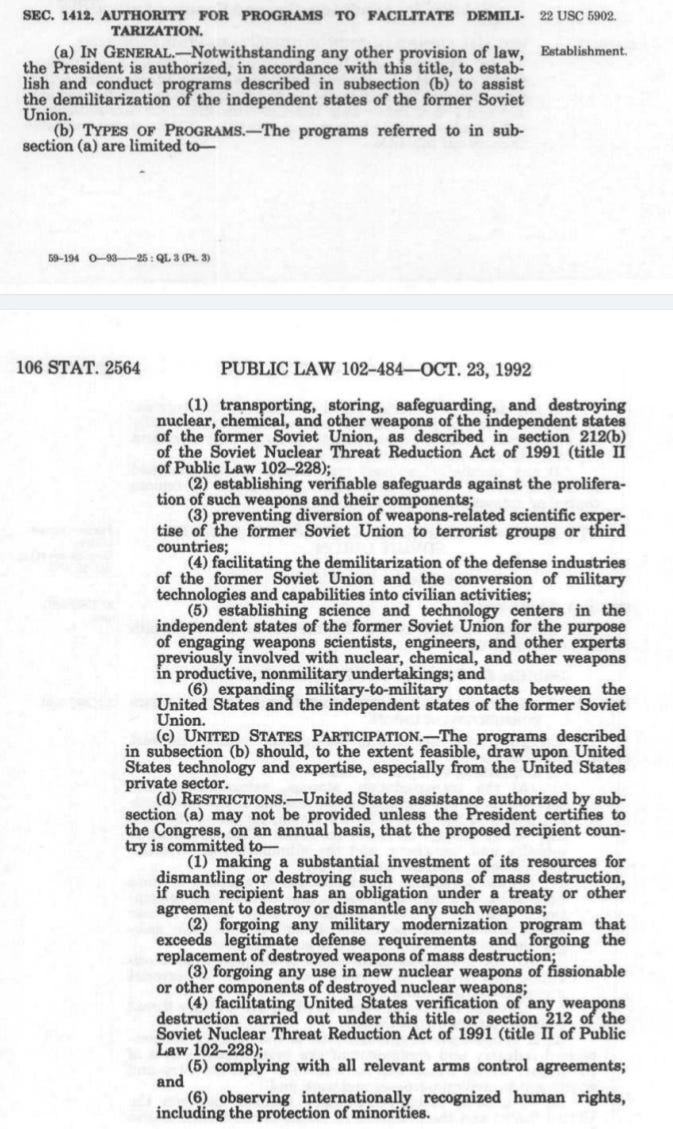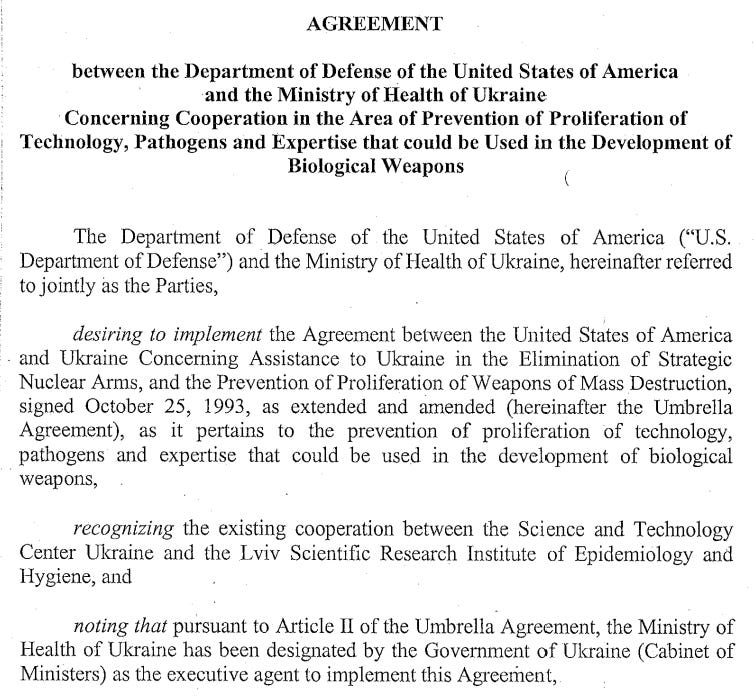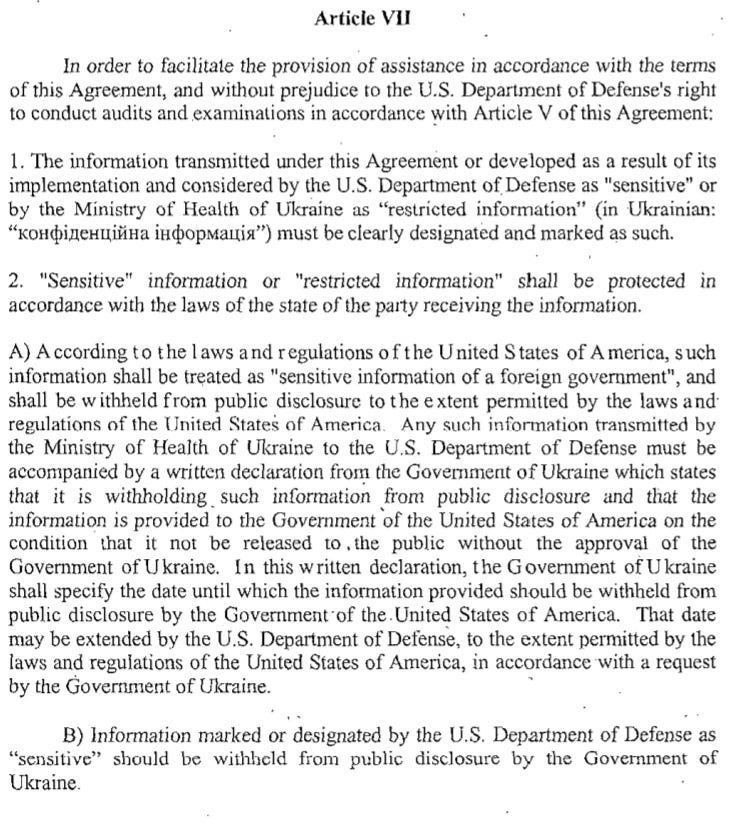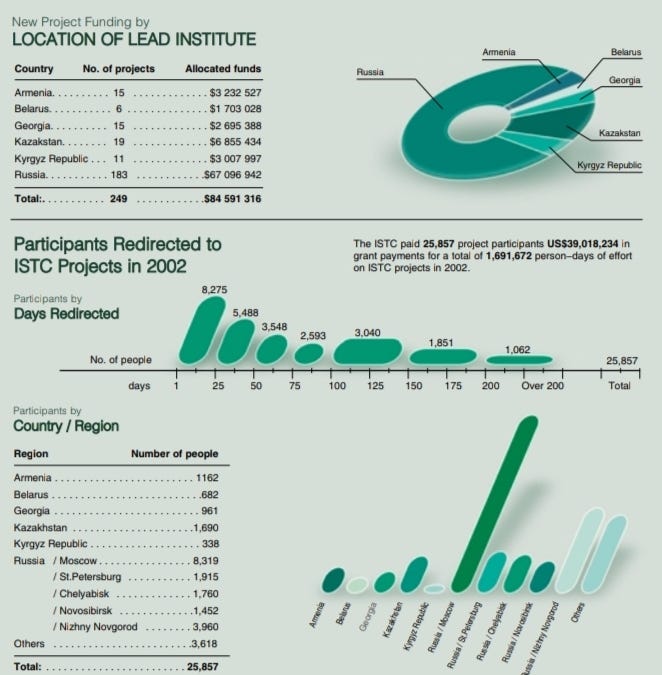When Is Bioweapons Research Not Bioweapons Research?
Answer: When It's "Threat Reduction"
When digesting the recent corporate media confirmations revelations of US backed (run?) biolabs in Ukraine there are several points that must be kept in mind:
The labs exist.
The labs are part of a working relationship—the Cooperative Threat Reduction Program (CTR)—between the US and Ukraine (along with the other newly independent states emerging from the Soviet Union) dating back to collapse of the Soviet Union in 1991.
The 2005 agreement between the US and Ukraine for funding the labs was an expansion of CTR, as the program increased its emphasis on biological weapons and threats.
Russia was a part of CTR up until 2012.
One signature element of CTR, the International Science And Technology Center, was headquartered in Moscow until the Russian withdrawal from CTR.
Through the ISTC (and by extension CTR), Russia received funding for research involving “dangerous pathogens” such as variola (smallpox).
A stated purpose of the ISTC (and the 2005 expansion agreement with Ukraine) was to put unemployed WMD scientists back to work.
The Biological Weapons Convention, to which both the US and Russia are formal parties, explicitly bans the creation and storage of biological weapons, or the components thereof.
It is important to keep this historical framework in mind, because one thing is made immediately plain by this history: the Ukrainian labs—and at least some of their work—are hardly a “secret”. Whatever political or moral issues arise from their existence, qualms of cloak-and-dagger secrecy is not among them.
Russia Signed Then Ignored The BWC
The Biogical Weapons Convention is fairly short, as treaties go—a mere fifteen articles. Article I lays out the fundamental thrust of the treaty in unambiguous terms.
Each State Party to this Convention undertakes never in any circumstances to develop, produce, stockpile or otherwise acquire or retain:
(1) microbial or other biological agents, or toxins whatever their origin or method of production, of types and in quantities that have no justification for prophylactic, protective or other peaceful purposes;
(2) weapons, equipment or means of delivery designed to use such agents or toxins for hostile purposes or in armed conflict,
There is very little wiggle room in the treaty language; any biological agent that has no actual peaceful use is off limits to all parties to the BWC.
While Russia signed the BWC in 1972 and ratified it in 1975, the country nevertheless maintained a fairly large and sophisticated bioweapons program up until the fall of the Soviet Union—some suggest the Soviet bioweapons program was the largest and most sophisticated of any nation. Its “public position” was to reject biological weapons by signing the BWC, but its “private position” was to ignore the BWC almost from the moment Russia signed the treaty.
As a direct consequence, when the Soviet Union was headed for dissolution in 1991, biological weapons were a part of the WMD question: what to do with the weapons and the infrastructure that developed them?
I will pause to note that the United States also maintained a bioweapons program throughout the 1950s and 1960s. Signature research facilities such as Fort Detrick—officially, the U.S. Army Medical Research Institute of Infectious Diseases (USAMRIID)—were developed as a result, and were redirected, at least officially, into “peaceful” biological research programs after President Nixon ended US biological weapons research by executive order in 1969. The weapons disposal issues presented by the fall of the Soviet Union therefore should not be viewed through a “good guy"/”bad guy" lens. There is no moral high ground regarding weapons of mass destruction—everyone's hands are dirty. The US was in the position of dealing with dismantling Russian WMD infrastructures simply because it was the Soviet Union that fell apart and not the US.
Nunn-Lugar: The Beginning Of “Threat Reduction”
As with the Soviet nuclear weapons program, its bioweapons program represented a significant investment in both infrastructure and research talent. While the Soviet Union officially ceased to exist at the end of 1991, neither the nuclear nor biological weapons infrastructures could just simply disappear. The US answer to the question of what to with these infrastructures was the Soviet Nuclear Threat Reduction Act of 1991, also known as the Nunn-Lugar Act, after the two principal authors of the legislation.
The initial premise of threat reduction was that the weapons and related infrastructures should be destroyed, dismantled, or converted to civilian “peaceful” use as appropriate. The program authorization (Section 212 of the Act) explicitly describes programs of weapons destruction.
Note that long term storage was not an authorized option under the 1991 legislation. Under Nunn-Lugar, weapons were to be destroyed, period.
How did the threat reduction of destroying bioweapons become the threat reduction of storing and studying them?
A principal reason was the realization that, while weapons can be destroyed, the knowledge housed within the scientists and technical personnel involved in their design and manufacture could not. Moreover, with the dismantling and demilitarization of key Soviet defense industries, a large number of these scientists and technical personnel were suddenly unemployed, and the concern arose about their skills being hired out to Third World countries and terrorist groups looking to acquire weapons of mass destruction. This led to the Former Soviet Union Demilitarization Act of 1992, which, among other things, authorized the US government to find ways to employ these individuals, directing their skills to civilian pursuits.
With this authorization in hand, the US set up the International Science And Technology Center, headquartered in Moscow, with the stated intention of putting former Soviet WMD scientists to work in “peaceful employment”.
The International Science and Technology Center (ISTC) was established in Moscow by international agreement in November 1992 as a nonproliferation program. ISTC coordinates the efforts of numerous governments, international organizations, and private sector industries, providing former weapons scientists (FWS) from Russia and the Commonwealth of Independent States (CIS) with new opportunities for sustainable, peaceful employment.
A similar entity, the Science And Technology Center In Ukraine, was created the following year, to specifically address the situation of former weapons scientists in Azerbaijan, Georgia, Moldova, Ukraine, and Uzbekistan, all of whom had established their independence duing the dissolution of the Soviet Union. The STCU has a mandate similar to the ISTC: put former weapons scientists to work:
STCU Mission:
• To address the global security threat of the proliferation of WMD-applicable chemical, biological, radiological and nuclear (CBRN) knowledge and materials;
• To support the integration of scientists with WMD applicable knowledge into global scientific and economic communities through national, regional, and international research collaboration;
• To develop and sustain a culture of nonproliferation and CBRN security awareness and responsibility through education, mentorship, and training;
• To promote international best practices and security culture to mitigate CBRN security threats.
It is worth noting that the founding agreement establishing the STCU contains a specific provision ensuring diplomatic immunity for STCU staff:
ARTICLE XII
Personnel of the United States Government, Canadian Government, and Swedish Government who are present in Ukraine in connection with the Center or its projects and activities shall be accorded by the Government of Ukraine status equivalent to that accorded to administrative and technical staff under the Vienna Convention on Diplomatic Relations of April 18, 1961.
Personnel of the Center shall be accorded by the Government of Ukraine the following privileges and immunities, which usually accord to employees of international organizations, to wit:
Immunity from arrest, detention, and legal proceedings, including criminal, civil, and administrative jurisdiction with regard to words said or written by themselves or any acts performed in the course of their official duties;
Exemption from any income, social security, or other taxation duties, customs duties, or other charges on income derived from Center activities, except those that are normally incorporated in the price of goods or paid for services rendered;
Immunity from social security provisions, immigration restrictions, and alien registration; and
The right to import their furniture and personal effects, at the time of first taking up their post, free of any Ukrainian tariffs, dues, customs duties, import taxes, and other similar taxes or charges.
Why do those working in “threat reduction” require any level of diplomatic immunity? The agreement does not say.
In 1998, the Department of Defense consolidated its various threat reduction programs under a single agency, the Defense Threat Reduction Agency, with a goal of bringing institutional cohesion and coherence to the ongoing threat reduction efforts in the former Soviet Union and elsewhere—and with the explicit conceit that biological weapons as well as chemical weapons were an ongoing threat, international treaties banning such weapons be damned.
By September 1997, the main ingredients for the defense reorganization that led to the creation of the Defense Threat Reduction Agency were in place. “Fundamentally,” Hamre recalled, “it was a recognition that nonproliferation/counterproliferation is the agenda for this decade. That we did not have an intellectual underpinning for [understanding] biological or chemical weapons. That the nuclear mission had collapsed, or was collapsing, and that we needed to basically get a new institutional focus. That is what drove it [DTRA’s establishment].”
What had come to be known as the Nunn Lugar Cooperative Threat Reduction Program was moved under the DTRA’s aegis, and efforts at biological threat reduction were consolidated and institutionalized qas the Biological Threat Reduction Program.
In 2005, US biological threat reduction efforts in Ukraine expanded again, with an agreement between the Department of Defense and the Ukrainian Ministry of Health whereby various biological research facilities in Ukraine would receive direct funding from the DoD Cooperative Threat Reduction Program.
U.S. cooperation with Ukraine under the Nunn-Lugar Cooperative Threat Reduction (CTR) program was expanded Aug. 29 with an agreement to use U.S. CTR funds to improve security for pathogens stored at biological research and health facilities in the former Soviet republic.
Under the agreement, CTR funds will for the first time flow directly to projects aimed at securing pathogen strains and sensitive biological knowledge within Ukraine. The United States also will work to improve Ukrainian capabilities to detect, diagnose, and treat outbreaks of infectious diseases, as well as determine whether outbreaks are natural or the result of bioterrorism.
The 2005 agreement is fairly short, but there are two points that warrant mention here.
The stated purpose of the agreement is to implement the original threat reduction agreement from 1993—12 years earlier.
The agreement anticipates the production of sensitive, classified information.
Bear in mind that the entirety of the Biological Threat Reduction Program takes place within the overarching framework of the Biological Weapons Convention. Ultimately, all “threat reduction” efforts must conform—by law—to the strictures of Article 1 of the BWC quoted above. Storing and studying dangerous pathogens without a “…justification for prophylactic, protective or other peaceful purposes” is categorically off limits.
Yet twelve years after commencing with “threat reduction” Ukraine was still “implementing” it, still had stockpiles of dangerous pathogens, and apparently was still likely to generate classified information regarding the stockpiles.
It is worth noting another provision of the BWC: stores of bioweapons are to be destroyed within nine months of a country's accession to the treaty (Article 2).
Each State Party to this Convention undertakes to destroy, or to divert to peaceful purposes, as soon as possible but not later than nine months after the entry into force of the Convention, all agents, toxins, weapons, equipment and means of delivery specified in Article I of the Convention, which are in its possession or under its jurisdiction or control. In implementing the provisions of this Article all necessary safety precautions shall be observed to protect populations and the environment.
The Nunn-Lugar Cooperative Threat Reduction Program began in 1991. The related agreement for dealing with Ukrainian WMDs dates to 1993. In 2005, the threat reduction efforts in Ukraine still were not done after 12 years—long after the deadline under the BWC had passed.
What was Ukraine doing with its stores of dangerous pathogens from 1993 to 2005? Why would at least some part of whatever it had been doing warrant being considered classified information?
The evolution of threat reduction and nonproliferation efforts in Ukraine raise those questions at a minimum. Even if the research being done is legitimately not “bioweapons research”, that by itself is no guarantee the research is either benign or ethical.
Proliferating Nonproliferation
As Ronald Reagan so aptly observed in 1964:
Actually, a government bureau is the nearest thing to eternal life we'll ever see on this earth.
Certainly that can be said about the government's “nonproliferation” programs. Not only are they still in existence a full thirty years after the dissolution of the Soviet Union (Declaration 142-H of the Supreme Soviet of the USSR declared the Soviet Union officially dissolved December 26, 1991), they have grown, spread, and—as the documents cited here demonstrate—proliferated.
Ukraine’s accession to the Biological Weapons Convention as part of the Soviet Union was sustained through its transition to an independent state, obligating it once independent to immediately destroy its stores of bioweapons and dangerous pathogens used to create bioweapons, and to dismantle the infrastructure used to produce both. Research facilities and personnel were required, per the BWC, to be immediately redirected towards benign, beneficial, peaceful purposes. Despite US assistance, which began even as the Soviet Union was still formally dissolving in late 1991, these obligations were demonstrably unmet in 2005; the agreement to fund Ukrainian nonproliferation efforts directly through CTR is absolute proof of this.
It is quite reasonable to ask at what point is the threat reduction objective achieved? Will it ever be achieved, or is threat reduction yet another example of the government immortality derided by Ronald Reagan in 1964?
It is also reasonable to ask how biological research under the rubric of “threat reduction” is substantially different from “bioweapons research”. The anthrax strain used in the 2001 terror attacks was a “vaccine challenge” strain—a strain intentionally made more virulent in order to “stress test" anthrax vaccines. As Dr. Paul Keim stated publicly in 2011:
We were surprised it was the Ames strain. And it was chilling at the same time, because the Ames strain is a laboratory strain that had been developed by the U.S. Army as a vaccine-challenge strain. We knew that it was highly virulent. In fact, that’s why the Army used it, because it represented a more potent challenge to vaccines that were being developed by the U.S. Army. It wasn’t just some random type of anthrax that you find in nature; it was a laboratory strain, and that was very significant to us, because that was the first hint that this might really be a bioterrorism event.
The Ames anthrax strain might not have been intended as a bioweapon, yet it became one the moment samples were stolen and used to attack people.
The Ames anthrax strain is one example of “threat reduction” turned into “threat creation”. How many other examples might there be within the thirty year history of the Nunn-Lugar Cooperative Threat Reduction Program?
And Then There's Russia
Given Russia’s accusations of the US maintaining a bioweapons research network in Ukraine, we do well to remember that Russia herself has benefited greatly from CTR funding, primarily through the ISTC. As the annual reports of the ISTC document, Russia was the largest recipient of project funding through the ISTC.
From the 2002 annual report:
From the 2003 annual report:
What kind of projects did the ISTC underwrite in Russia? All kinds, including research involving variola (smallpox), other orthopoxvirus (cowpox virus), and avian influenza, as the completed projects of just one Russian research facility, the State Research Center of Virology and Biotechnology VECTOR, illustrate.
The mapping of the monkeypox virus genome was a collaborative work involving the VECTOR lab, the CDC, and Fort Detrick.
Update (20 May 2022): Since March the ISTC website has been scrubbed of all mention of the VECTOR biolab, and the ISTC reference to the monkeypox genome mapping project (https://www.istc.int/en/project/9657518C7DC7FBF04325691F0016B388) completely “memoryholed”. The peer reviewed write up of the project in the June 5, 2002, issue of Virology is still available, however, and has been archived.
While these projects all are claimed to have “prophylactic, protective, or other peaceful purposes”, as the Ames anthrax strain demonstrates all too well, the difference between that and bioweapons research can hinge on a single lab mistake or malfeasance.
Moreover, it strains credulity to assume that Russia, having received tens of millions of dollars annually in threat reduction funding, had no indication of the range of threat reduction research in Ukraine, or of the potential for misuse and misdirection of the research.
Quite simply, as Russia fed for many years at the same CTR trough as Ukraine, it must be presumed that Russia was at least broadly aware of the nature of that funding. Russia has known about the Ukrainian labs all along, and has had no problem with it until now.
Bioweapons Research Or Threat Reduction?
Ultimately, the distinction between what constitutes “bioweapons research” versus “threat reduction research” is a rather Clintonian parsing of the terms.
Regardless of the terms, the research activities involved target dangerous pathogens. Regardless of the terms, the research demands the storage of dangerous pathogens. Regardless of the terms, the research invites if not demands the strictest of scrutiny to ensure it remains within the parameters of the BWC.
Moreover, regardless of the requirements of the BWC, it is a proven fact that virtually all nations conduct research involving dangerous pathogens. Russia certainly does, and the COVID pandemic is absolute proof that China does as well—and COVID is, like the Ames anthrax strain, a grim reminder how easy it is for threat reduction to become threat creation.
This much is certain: once a dangerous pathogen escapes the confines of the lab, the matter of bioweapons research versus threat reduction research quickly becomes a distinction without a difference.









Thanks very much for this extensive overview and analysis, which you directed me to from discussions following https://newsletter.allfactsmatter.us/p/what-to-do-with-jordon-walker .
Still not convinced that COVID 19 was not a domestic product of Fauci & his minions.
All very murky.